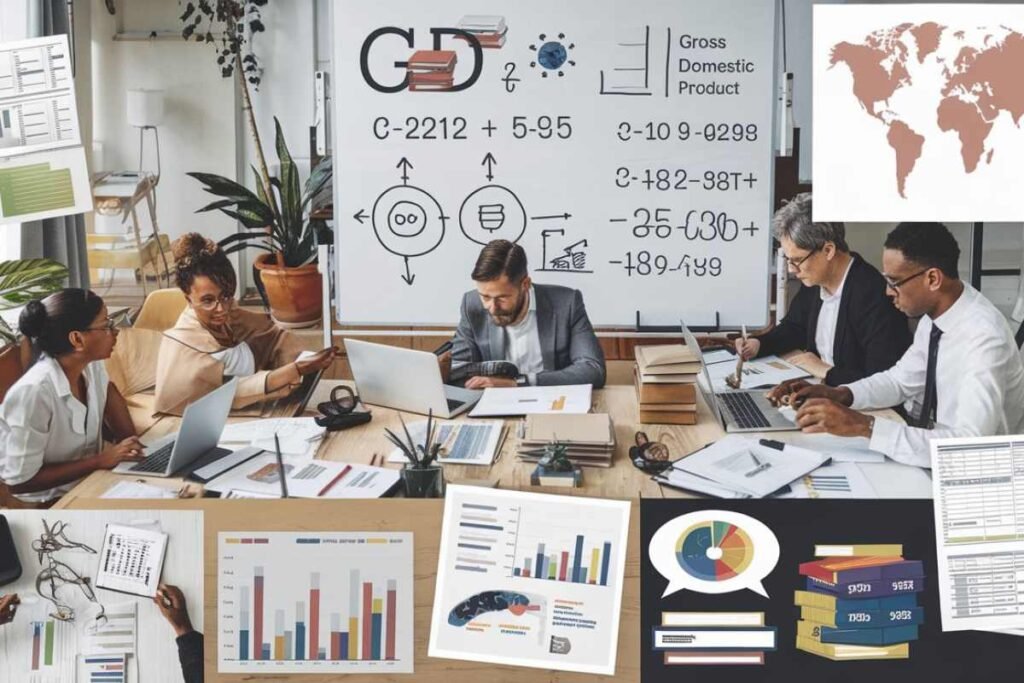Table of Contents
Gross Domestic Product (GDP) is one of the most frequently cited indicators of a country’s economic health. However, understanding what GDP truly represents and how it’s measured can be complex.
In this article, we will explore what happens behind the scenes to produce the GDP Behind The Scenes figures that influence economic policies and business decisions worldwide.
What is GDP Behind The Scenes?
GDP stands for Gross Domestic Product. It measures the total monetary value of all goods and services produced within a country’s borders over a specific period, typically a year or a quarter.
It is a crucial indicator used by governments, economists, and analysts to gauge the economic performance of a country.
The Components of GDP

GDP can be measured using three different approaches:
Production (or Output) Approach
This approach calculates GDP by adding up the value of all goods and services produced in the economy, minus the value of goods and services used up in production. Essentially, it measures the net output.
Income Approach
This approach sums up all incomes earned by individuals and businesses in the economy, including wages, profits, rents, and taxes, minus subsidies. It reflects the distribution of economic output.
Expenditure Approach
This method adds up all expenditures made in the economy, including consumer spending, investment, government spending, and net exports (exports minus imports). It highlights how the output is distributed among different sectors.
The Process of Measuring GDP
Data Collection
The first step involves collecting data from various sources, including business surveys, government reports, and administrative records. This data includes information on production levels, income, consumption, and investments.
Data Aggregation
Once collected, data is aggregated to avoid double counting. For instance, intermediate goods used in production are excluded from the final GDP calculation to ensure that only the value of final goods and services is measured.
Adjustment for Inflation
To compare GDP across different time periods, it is adjusted for inflation. This results in Real GDP, which reflects the actual growth in economic output by removing the effects of price changes.
Seasonal Adjustments
GDP data is also adjusted for seasonal variations. This is crucial for obtaining a clear picture of economic trends without the distortions caused by seasonal factors such as holiday spending or agricultural cycles.
Challenges and Limitations

Accuracy of Data
The accuracy of GDP measurements depends on the quality of data collected. Inaccurate or incomplete data can lead to misleading GDP figures.
Informal Economy
In many countries, especially developing ones, a significant portion of economic activity occurs in the informal sector, which is not always accurately captured in GDP measurements.
Social Indicators
GDP does not measure other important aspects of economic health, such as income distribution, environmental impact, or quality of life. Thus, a growing GDP does not necessarily equate to improved living standards for all citizens.
The Role of GDP in Policy Making
Governments and central banks use GDP data to formulate economic policies. A rising GDP might signal a healthy economy, leading to policies aimed at controlling inflation or managing interest rates.
Conversely, a declining GDP might prompt stimulus measures or changes in fiscal policies to spur economic growth.
Conclusion
In conclusion, while GDP remains a fundamental economic indicator providing insights into the overall economic activity within a country, it is important to recognize its limitations and the complexities involved in its measurement.
Understanding the behind-the-scenes processes, from data collection to adjustments for inflation and seasonality, helps in interpreting GDP Behind The Scenes figures more accurately.
However, policymakers and analysts must also consider other social and economic factors beyond GDP to gain a comprehensive view of a nation’s economic well-being and to implement effective policies that promote sustainable growth and improve quality of life for all citizens.
FAQs
What does GDP stand for?
GDP stands for Gross Domestic Product.
What does GDP measure?
GDP measures the total monetary value of all goods and services produced within a country over a specific period.
What are the three main approaches to measuring GDP?
The three main approaches are the Production (or Output) Approach, the Income Approach, and the Expenditure Approach.
Why is GDP adjusted for inflation?
GDP is adjusted for inflation to provide a more accurate reflection of real economic growth, removing the effects of price changes.
What is Real GDP?
Real GDP is GDP adjusted for inflation, reflecting the true growth in economic output.
Why are seasonal adjustments made to GDP data?
Seasonal adjustments are made to account for predictable fluctuations due to seasonal factors, providing a clearer view of economic trends.
What are some limitations of GDP as an economic indicator?
GDP does not measure income distribution, environmental impact, or quality of life, and it may not accurately capture informal economic activities.
How do governments use GDP data?
Governments use GDP data to formulate economic policies, manage inflation, and make decisions about fiscal and monetary measures.


